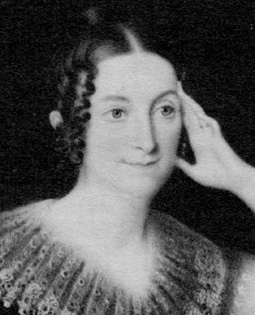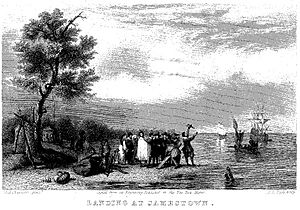Lydia Sigourney facts for kids
Quick facts for kids
Lydia Huntley Sigourney
|
|
|---|---|
 |
|
| Born | September 1, 1791 Norwich, Connecticut |
| Died | June 10, 1865 (aged 73) |
Lydia Huntley Sigourney (born September 1, 1791 – died June 10, 1865) was an important American poet in the early and mid-1800s. She was often called the "Sweet Singer of Hartford". Most of her writings were published using her married name, Mrs. Sigourney.
Contents
About Lydia Sigourney
Her Early Life
Lydia Sigourney was born in Norwich, Connecticut. Her parents were Ezekiel Huntley and Zerviah Wentworth. She was their only child. She was named after her father's first wife, Lydia Howard, who had passed away shortly after they married.
In her autobiography, Letters of Life, Lydia wrote about how much she loved her parents. She felt it was her duty as their only child to care for them.
Her Education and Schools
Lydia went to school in Norwich and Hartford. In 1811, she opened a school for young ladies in Norwich with her friend Nancy Maria Hyde. The school closed when Nancy became ill.
After that, Lydia started another school in Hartford from 1814 to 1819. This school was in the home of Daniel Wadsworth. Daniel Wadsworth was a kind supporter who helped her a lot. He helped her set up the school by arranging for his friends' daughters to attend.
In 1815, Daniel Wadsworth also helped Lydia publish her first book, Moral Pieces in Prose and Verse. He handled the publishing and even edited the book himself. Lydia called him her "kind patron" because he helped her so much.
Her Married Life
On June 16, 1819, Lydia married Charles Sigourney. After getting married, she chose to write secretly in her free time. She only started writing openly as Mrs. Sigourney when her parents needed financial help and her husband's money situation changed. When people guessed she was the author of an anonymous book called Letters to Young Ladies, By a Lady, she admitted it and began to publish under her own name.
Lydia Sigourney's Impact
Lydia Sigourney was one of the most popular writers of her time. She was well-known in both the United States and England. People even called her 'the American Hemans', comparing her to a famous British poet.
Her writings were known for being smooth, graceful, and thoughtful. She often wrote about nature, home life, religious topics, and helping others. While some of her work was seen as sentimental, she also wrote powerful poems like 'Niagara' and 'Indian Names'. The song 'Indian Names' was even put to music by Natalie Merchant for her 2010 album, Leave Your Sleep.
Lydia was very interested in helping people and supporting education. She used her position to speak out about important issues like Native American rights and injustices. In her autobiography, Letters of Life, she said she wrote hoping to "be an instrument of good."
Her influence was huge. She inspired many young women to become poets themselves. As a successful writer, Lydia showed young women that they could achieve fame and earn money through writing.
Rev. E. B. Huntington, who wrote about Lydia after her death, believed her success came from her kindness. He said her "goodness had made her great" and her "loving friendliness had made herself and her name everywhere a charm." She truly wrote to inspire others.
Lydia Sigourney wrote more than two thousand articles for nearly 300 different magazines and newspapers. She also published about 67 books.
In 1844, Sigourney, Iowa, a town in Keokuk County, Iowa, was named in her honor. A large painting of Lydia can still be seen in the county courthouse there. Her poem "Sailor's Hymn At Parting" was even quoted in the 2019 film The Lighthouse.
The Lyceum Movement
Lydia Sigourney's dedication to education, writing, and charity showed women what they could achieve. When she started writing openly, she became one of the most famous female authors and poets in America.
Because of her fame, many literary societies and study clubs were named after her during the lyceum movement in the 1800s. The lyceum movement was a time when people gathered to learn and discuss topics like literature and science.
Here are some examples of societies named after her:
- Sigourney Society (Oxford, New York) — started around 1836.
- Sigourney Society (Gaffney, South Carolina) — started in 1848. Lydia Sigourney was invited to be an honorary member, and she accepted.
- Sigourney Society (Griffin, Georgia) — started around 1848–1858.
- Sigournian Literary Society (Pennsylvania) — a society for young ladies, started around 1851.
- Sigournian Society (Centreville, Indiana) — started in 1856.
- Sigournean Society (Moore's Hill, Indiana) — a women's literary society, started in 1857.
- Sigournean Society (Indianapolis, Indiana) — the first literary society for women at North Western Christian University (now Butler University), started in March 1859. This society published a newsletter called The Sigournean Casket.
- Sigournean Society (Greensboro, North Carolina) — started before 1863.
- Sigournean Society (Batavia, Illinois) — started around March 1866.
- Young Ladies' Sigournean Band (Kokomo, Indiana) — active around the 1870s.
- Sigournean Club (Olathe, Kansas) — a women's study club, started in 1890 and active until the 1970s. Its goal was "the attainment of a higher plane of life through broad culture, free discussion and mutual helpfulness."
- Sigournean Club (Winfield, Kansas) — an afternoon study club, started in 1898 to study art and literature.
- Sigournean Club (Ottawa, Kansas) — started before 1899. This club donated a library of 50 books to the Kansas Traveling Libraries in 1899.
Many other societies were likely named in honor of Lydia Huntley Sigourney during this time.
Selected Works

- Evening Readings In History (1833)
- Letters to Young Ladies (1833), one of her most famous books
- Pleasant Memories of Pleasant Lands (1842), about her trip to Europe in 1840
- Scenes in My Native Land (1844)
- Letters to My Pupils (1851)
- Olive Leaves (1851)
- The Faded Hope (1852) written in memory of her only son, who died at age nineteen
Images for kids


